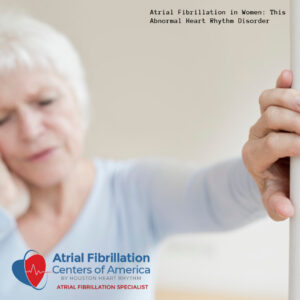Atrial Fibrillation in Women
Atrial fibrillation in women, also known as AFib, is the most common heart rhythm disorder, affecting over 6 million Americans. While atrial fibrillation can occur in both men and women, there are some necessary differences that should be penned down in how this condition happens and is treated in women.
Prevalence and Risk Factors
The risk of developing this disease increases significantly for women as they age. After the age of 75, the prevalence of AFib is similar between men and women. Some of the key risk factors for AFib that are unique to or more common in women include:
- Hormonal changes associated with menopause
- Hypertension during pregnancy (preeclampsia)
- Obesity
- Thyroid disorders
Symptoms:-
The symptoms of atrial fibrillation includes the following
- Palpitations
- Fatigue
- Shortness of breath
- Chest pain or discomfort
- Lightheadedness or dizziness
However, studies show that women are more likely to have “silent” AFib with no symptoms. Due to this reason, the condition often goes undiagnosed.
Although, it sounds a bit absurd that Afib sometimes doesn’t show symptoms in women but it does have a logical explanation which is:-
- Smaller Atria Size – Women tend to have smaller atria chambers in their hearts compared to men. Since AFib symptoms are often related to how much the atria quiver and contract irregularly, smaller atria may result in fewer noticeable symptoms.
- Lower Intensity of Symptoms – Some studies have found that even when women experience AFib symptoms, they report lower symptom intensity and frequency compared to men. Women may have more periodic or paroxysmal AFib which causes milder symptoms.
- Higher Pain Threshold – Research indicates that women generally have a higher pain threshold and tolerance than men. This could mean they are less likely to perceive or get bothered by subtle AFib symptoms like palpitations or discomfort.
- Less Adrenaline Release – AFib symptoms are often triggered by surges of adrenaline. Some evidence suggests women may have lower adrenaline production in response to AFib, resulting in less noticeable symptoms.
- Autonomic Regulation – Women may have better parasympathetic regulation of heart rhythm which helps compensate for AFib. This autonomic control could potentially dampen symptoms.
- Hormonal Influence – Estrogen may have protective effects on electrical remodeling of the heart, while progesterone may have arrhythmogenic effects. These influences could modulate AFib symptoms.
Complications:-
As discussed in the previous part about some situations where the body shows no symptoms which leads to non diagnosis of the condition wherein unknowingly situation is left untreated. There are some serious complications & risks associated with untreated Afib in Women.
- Women with AFib have a 3-to-5 fold increased risk of stroke compared to women without AFib.
- Pregnant women with AFib also have increased chance of pregnancy complications.
- Heart failure and dementia are other common complications that may occur in patents with AFIB.
The above complications clearly suggests why an early diagnosis and treatment are truly critical, especially in women with subtle or no symptoms.
Diagnosis and Treatment:-
Afib can be easily detected through different diagnostic tests like ECG and Holter monitoring. Infact, today newer wearable heart monitors may also improve diagnosis in asymptomatic women.

Treatment options include medications to regulate heart rhythm or control heart rate, cardioversion, catheter ablation procedures, and for some patients, surgery or pacemakers. Anticoagulants are important to reduce stroke risk. Please do consult electrophysiologist before taking any medicines.
Better life measures like maintaining a healthy weight, regular exercises, avoiding/reducing alcohol intake, and managing underlying conditions are some of .
Final Takeaway:-
AFib is an abnormal heart rhythm disorder characterized by rapid, irregular beating of the atria (upper chambers of the heart). This causes an irregular and often fast heart rate. Before the age of 75, men have a higher risk of AFib than women. But after 75, the risk becomes similar between men and women. Key risks in women include menopause, hypertension in pregnancy, obesity, and thyroid disorders. Women are also more likely to have “silent” AFib with no symptoms. However, diagnostic tests like ECG, Holter monitoring, and newer wearable heart monitors can help detect AFib. When it comes to testing for afib, it is important especially in women with no symptoms.
If left untreated, serious complications include stroke, heart failure, dementia, and pregnancy complications can be there in the body. Women with AFib have 3-5 times higher risk of stroke than women without it. There are many treatment options which include medications, cardioversion, catheter ablation, pacemakers, and surgery. However, nothing can beat some good lifestyle changes like making exercise a part of one’s routine. Maintaining a healthy weight, reducing alcohol intake & smoking, and managing conditions like high blood pressure comes under lifestyle changes. Getting proper screening and treatment can also help prevent complications.
Atrial Fibrillation Centers of America is here to perform safe and effective procedures! Talk to us now at (832) 478-5067 or pay us a visit at 13325 Hargrave Rd. Suite 280, Houston, TX 77070.
